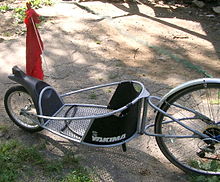Cardanic suspension



The gimbal or gimbal bearing ( engl. Gimbal ) is hanging an object on a frame by means of two intersecting mutually perpendicular pivot bearings .
It is used, for example, on ships for measuring instruments or other objects. The center of gravity of the object to be stored is located below the intersection of the axes of rotation of the pivot bearings, so that the object does not yield to any inclination of its surroundings. In contrast to hanging on a thread, the object does not rotate around the vertical axis. The picture on the right shows that the compass bowl remains horizontal (both when tilted to the side as shown and when pitching around the transverse axis of the ship).
A common application is the cardanic suspension of a rotating mass ( top ) in a gyroscope .
The same technical principle (two crossed swivel joints) is used in the universal joint to transmit a rotary movement between two mutually pivotable shafts .
The cardan suspension is named after Gerolamo Cardano (1501–1576), who described it in 1560.
history
A cardanic suspension was probably used as early as 280–220 BC. Used by Philon of Byzantium to hang an inkwell. This countered the risk of accidentally knocking it over. In China the cardanic suspension can be proven around 180 AD. A drawing by Villards de Honnecourt proves that it was known in the Middle Ages (see picture ). Leonardo da Vinci proposed the cardanic suspension for a ship's compass .
How it works and uses
In the outer fixed part (often but not necessarily a ring), two rings - the axes each offset by 90 degrees - are rotatably mounted in one another. The object to be stored is attached to the innermost ring.
In ship kitchens , the hotplates are gimbaled. Their center of gravity is kept so low by means of additional weights that they remain horizontal even with the pots on top when the ship is tilting, and do not slip away or even tip over. The horizontal position is also retained in the suspension of a ship's compass proposed by Leonardo da Vinci (see picture above ).
One of the gyroscopic instruments is the gyro compass . The gyro axis forms a right angle with the inner cardan axis (see picture). The cardanic suspension allows the gyro to maintain its direction in space when the vehicle (ship, airplane) changes direction. The initial direction of the vehicle can always be read from the direction of the gyro axis.
In floating tripods ( Steadycam ) for film and photo cameras gimbals are used for image stabilization. The English term gimbal is mostly used here. Telescopes are also partially gimbaled.
In propulsion of spacecraft , rocket engines are generally mounted on two gimbals so that a single engine can vector-thrust around both pitch and yaw axes ; sometimes only one axis per motor is used. Dual motors with differential pitch or yaw control signals are used to control gyro to provide torque about the vehicle's spherical axis.
Single track trailer
Single-track trailers for motorbikes and bicycles are usually coupled with the help of a cardan joint (left picture). The two freedoms in this coupling allow the trailer to be swiveled out to the side (cornering) and to move the trailer up and down (change in the incline of the road). In the longitudinal direction, the trailer is prevented by the towing vehicle from falling over to the side.
The construction, in which the trailer can be rotated up and down using a fork, is coupled to the rear wheel axle (picture on the right) is a special universal joint. The cross piece is the size of this fork, at the rear end of which the second - the vertical axis of rotation - is located. The center lines of the two cross-piece axes do not intersect at one point as usual.
Individual evidence
- ↑ Described by Cardano in De subtilitate , 1560.
- ^ Karl-Heinz Schlote: Chronology of the Sciences. Harry Deutsch, 2002, ISBN 3-8171-1610-1 , p. 41.

